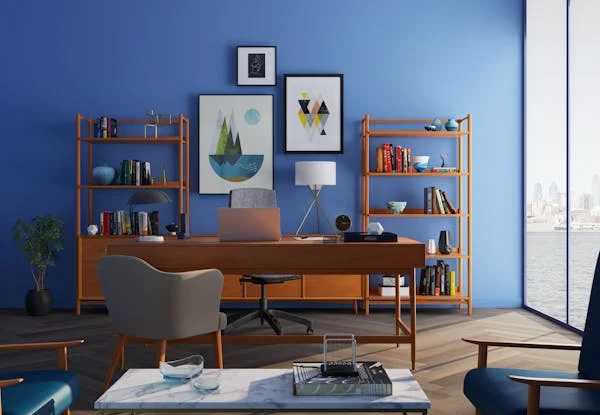

The right lighting design for office spaces plays a vital role in creating a productive and inspiring work environment.
A well-thought-out lighting plan boosts focus, comfort, and collaboration.
In fact, studies have proved that better lighting in office spaces can enhance employee well-being and productivity.
With a strategic lighting design for office spaces, one can combine aesthetic and functional elements for increased comfort and visual appeal.
A modern office lighting plan involves professional advice and customized solutions, ensuring energy efficiency.
An effective lighting design for office spaces includes a combination of various lighting elements to balance function and aesthetics:
• Ambient Lighting – Provides general illumination, setting the tone and brightness of the office.
• Task Lighting – Focused lighting that helps with specific activities such as reading, computer work, and meetings.
• Accent Lighting – Used to highlight architectural details, artwork, or design elements, adding depth to the space.
• Natural Light – Incorporating daylight into the office creates a refreshing and efficient setting, reducing reliance on artificial light.
Balancing these elements ensures that the office lighting remains practical, comfortable, and aesthetically pleasing.
1. Pendant Lights for Sleek Aesthetics
Pendant lights are a popular choice for lighting design for office spaces due to their modern and refined appeal.
Hanging pendant lights work great in meeting rooms because it focuses and brightens atmosphere.
Choose customizable pendant designs with adjustable lengths and various colors to complement specific parts of the office.
2. LED Strip Lights for Contemporary Vibes
LED strip lights are a stylish and efficient lighting choice for the office environment.
Install LED lights along walls, ceilings, or around design features to create a subtle, modern glow.
LED strip lights are available in different colors and dimmable options, offering versatility and energy efficiency.
3. Task Lighting to Boost Productivity
Task lighting is essential when planning lighting design for the office.
Adjustable desk lamps with LED bulbs, swing arms, and built-in dimmers help reduce eye strain and enhance comfort.
By incorporating task lights at each workstation, employees can control brightness based on their requirements.
4. Statement Chandeliers as Focal Points
Add a sophisticated and luxurious element to your lighting design for office.
Modern chandeliers bring elegance and act as a conversation starter in executive cabins or conference rooms.
Pick a fixture that reflects the company's character.
Chandeliers with a well-polished appearance make a strong impression on clients and visitors.
5. Maximizing Natural Lighting
Maximize windows and glass partitions in the office layout to improve your lighting design for office spaces.
Position desks and workstations near windows to allow daylight to flow through and reduce artificial light dependency.
To control glare, use sheer curtains or solar shades to maintain natural brightness while reducing screen reflections.
6. Smart Lighting for Modern Workspaces
Smart lighting systems provide flexible control of lights for office environments.
Smart lights can be adjusted remotely using apps or voice control.
They can also be scheduled for energy-saving features and security.
Incorporate motion sensors and dimmers to adjust the lighting as needed, automatically turning off lights in unused spaces, making it an eco-friendly and cost-effective solution.
7. Layered Lighting Techniques for Versatility
Layered lighting combines ambient, task, and accent lighting to create depth and dimension in lighting design for office spaces.
Start with recessed ceiling lights for general illumination, then add task lamps at workstations for focused lighting.
Complete the look with accent lighting, such as wall-mounted sconces or LED strips, to highlight architectural details.
Layered lighting allows you to adjust the brightness and mood based on different office activities.
8. Floor Lamps for Flexible Lighting
Floor lamps are a simple yet effective element in lighting design for office spaces.
A sleek, modern floor lamp positioned near a seating area or corner workstation adds both style and functionality.
Opt for floor lamps with adjustable heads and dimmable settings to provide the right amount of light for reading or focused work.
Metallic or matte black finishes enhance the modern office vibe.
9. Cove Lighting for Subtle Elegance
Cove lighting is an understated yet impactful addition to lighting design for office settings.
Installed in recesses or ledges along walls or ceilings, cove lighting creates a soft, indirect glow that adds warmth to the space.
This type of lighting works well in conference rooms and reception areas, providing a professional and welcoming atmosphere.
10. Artistic Light Fixtures for a Modern Touch
Artistic light fixtures double as both lighting and decor in lighting design for office environments.
Look for sculptural designs, asymmetrical shapes, and mixed metal finishes to create a unique and contemporary feel.
Artistic lighting is ideal for open spaces and reception areas, where it serves as a focal point and conversation starter.
An effective lighting design for office spaces enhances both the functionality and style of the work environment.
The right combination of ambient, task, and accent lighting creates a balanced and productive atmosphere.
From sleek pendant lights to smart LED solutions, each lighting element plays a vital role in shaping the overall mood and efficiency of the office.
Ubique Infra offers a wide range of stylish and innovative lighting solutions tailored to modern office spaces.
Contact us to upgrade your office with thoughtfully designed lighting that reflects your brand’s identity and boosts employee well-being.
Tags: lighting design for office
Leave a Reply
Your email address will not be published. Required fields are marked *